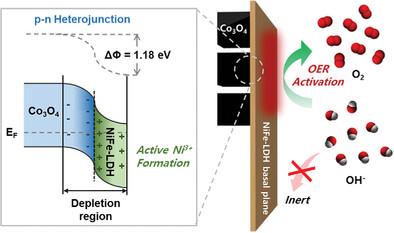当前位置:
X-MOL 学术
›
Adv. Energy Mater.
›
论文详情
Our official English website, www.x-mol.net, welcomes your
feedback! (Note: you will need to create a separate account there.)
Activation of Hidden Catalytic Sites in 2D Basal Plane via p–n Heterojunction Interface Engineering Toward Efficient Oxygen Evolution Reaction
Advanced Energy Materials ( IF 24.4 ) Pub Date : 2024-11-12 , DOI: 10.1002/aenm.202403722 Eugene Kim, Sungsoon Kim, Yongchul Kim, Kiran Hamkins, Jihyun Baek, MinJoong Kim, Tae‐Kyung Liu, Young Moon Choi, Jung Hwan Lee, Gyu Yong Jang, Kug‐Seung Lee, Geunsik Lee, Xiaolin Zheng, Jong Hyeok Park
Advanced Energy Materials ( IF 24.4 ) Pub Date : 2024-11-12 , DOI: 10.1002/aenm.202403722 Eugene Kim, Sungsoon Kim, Yongchul Kim, Kiran Hamkins, Jihyun Baek, MinJoong Kim, Tae‐Kyung Liu, Young Moon Choi, Jung Hwan Lee, Gyu Yong Jang, Kug‐Seung Lee, Geunsik Lee, Xiaolin Zheng, Jong Hyeok Park

|
Nonprecious metal‐based 2D materials have shown promising electrocatalytic activity toward the oxygen evolution reaction (OER). However, the catalytically active sites of 2D materials are mainly presented at the edge, and most of their basal planes are still catalytically inactive, which turns into a significant drawback on the catalytic efficiency. Here, a novel p–n heterojunction strategy is suggested that generates active sites on the basal plane of 2D NiFe‐layered double hydroxide (NiFe‐LDH). The n‐type NiFe‐LDH is first grown on a nickel foam (NF) substrate, and p‐type Co3 O4 nanocubes are deposited through a simple dip‐coating method to fabricate a Co3 O4 /NiFe‐LDH@NF p–n heterojunction electrode. As a result, electron transfer is induced at the interface of p‐type Co3 O4 and n‐type NiFe‐LDH, which consequently promotes oxidation of the inert Ni2+ state to a more catalytically active Ni3+ state on the inert basal plane of NiFe‐LDH. As‐prepared Co3 O4 /NiFe‐LDH@NF electrodes obtained enhanced OER performance showing a high current density of 100 mA cm−2 at 1.48 V (vs RHE) which outperforms that of pristine NiFe‐LDH@NF. The utilization of the p–n junction concept will disclose a new strategy for modifying the electronic structure of the catalytically inactive basal plane and stimulating its electrocatalytic activity.
中文翻译:

通过 p-n 异质结界面工程激活 2D 基平面中隐藏的催化位点,以实现高效的析氧反应
非贵金属基 2D 材料已显示出对析氧反应 (OER) 的良好电催化活性。然而,二维材料的催化活性位点主要呈现在边缘,其大部分基面仍处于催化不活跃状态,这成为催化效率的显著缺点。在这里,提出了一种新的 p-n 异质结策略,可在 2D NiFe 层状双氢氧化物 (NiFe-LDH) 的基平面上产生活性位点。n 型 NiFe-LDH 首先在泡沫镍 (NF) 衬底上生长,然后通过简单的浸涂方法沉积 p 型 Co3O4 纳米立方体,以制造 Co3O4/NiFe-LDH@NF p-n 异质结电极。结果,在 p 型 Co3O4 和 n 型 NiFe-LDH 的界面上诱导电子转移,从而促进惰性 Ni2+ 态在 NiFe-LDH 的惰性基平面上氧化为更具催化活性的 Ni3+ 态。制备的 Co3O4/NiFe-LDH@NF 电极获得了增强的 OER 性能,在 1.48 V (vs RHE) 下显示出 100 mA cm-2 的高电流密度,优于原始 NiFe-LDH@NF。p-n 结概念的利用将揭示一种改变催化失活基平面的电子结构并刺激其电催化活性的新策略。
更新日期:2024-11-12
中文翻译:

通过 p-n 异质结界面工程激活 2D 基平面中隐藏的催化位点,以实现高效的析氧反应
非贵金属基 2D 材料已显示出对析氧反应 (OER) 的良好电催化活性。然而,二维材料的催化活性位点主要呈现在边缘,其大部分基面仍处于催化不活跃状态,这成为催化效率的显著缺点。在这里,提出了一种新的 p-n 异质结策略,可在 2D NiFe 层状双氢氧化物 (NiFe-LDH) 的基平面上产生活性位点。n 型 NiFe-LDH 首先在泡沫镍 (NF) 衬底上生长,然后通过简单的浸涂方法沉积 p 型 Co3O4 纳米立方体,以制造 Co3O4/NiFe-LDH@NF p-n 异质结电极。结果,在 p 型 Co3O4 和 n 型 NiFe-LDH 的界面上诱导电子转移,从而促进惰性 Ni2+ 态在 NiFe-LDH 的惰性基平面上氧化为更具催化活性的 Ni3+ 态。制备的 Co3O4/NiFe-LDH@NF 电极获得了增强的 OER 性能,在 1.48 V (vs RHE) 下显示出 100 mA cm-2 的高电流密度,优于原始 NiFe-LDH@NF。p-n 结概念的利用将揭示一种改变催化失活基平面的电子结构并刺激其电催化活性的新策略。


















































 京公网安备 11010802027423号
京公网安备 11010802027423号